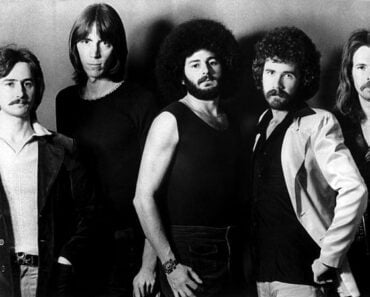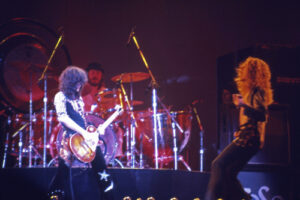
Feature Photo: Bernie Ilson, Inc., Public domain, via Wikimedia Commons
If someone tries to dismiss The Temptations as having “nothing to do with classic rock,” they’re ignoring a fundamental truth about what classic rock actually represents. Classic rock is not defined by a single guitar tone or a rigid genre box, it is about a spirit of musical innovation, a blending of influences, and a passion that transcends labels. The Temptations embodied all of that. Their music, particularly in their late 1960s and early 1970s “psychedelic soul” era, was steeped in grooves that carried the same drive and energy found in rock and roll. Tracks like “Ball of Confusion” and “Papa Was a Rollin’ Stone” were not just soul records, they were bold, electrifying performances that fused rock rhythms, socially charged lyrics, and the kind of urgency that defined the classic rock era.
The Temptations also influenced generations of rock musicians. Their harmonies, stage presence, and ability to push the boundaries of popular music inspired artists well beyond the R&B world. The Funk Brothers’ instrumental firepower on their records carried the grit and punch of a rock band in full swing, while the group’s own vocal performances delivered a raw power that resonated with the same rebellious energy that fueled the rise of rock music.
Even if you don’t classify The Temptations as a “rock band” in the traditional sense, their work is inseparable from the history of classic rock. They were part of the same cultural explosion that gave us The Rolling Stones, The Beatles, and countless others. They shared the stage, the radio waves, and the hearts of listeners who didn’t draw hard lines between genres. Their songs were a crucial part of the soundtrack of an era when rock and soul lived side by side, influencing and borrowing from one another.
That’s why a list of “rocking” Temptations songs makes perfect sense. They may have been marketed as an R&B group, but the passion, innovation, and social commentary in their music place them right in the center of the classic rock story. To leave them out is to leave out an essential part of the movement’s soul.
# 10 – Ain’t Too Proud To Beg
We wanted to kick off this list with something exciting, and “Ain’t Too Proud to Beg” hits the mark perfectly. It is one of the most popular Temptations tracks that rock and roll fans instantly recognize, helped in no small part by the Rolling Stones’ spectacular cover version. That connection between the Temptations and the Stones captures exactly what this article is about, showing how the Temptations inspired rock artists and how rock, in turn, fed back into their sound. Written by Norman Whitfield and Edward Holland Jr. and produced by Whitfield, the song was recorded at Motown’s Hitsville U.S.A. studio in Detroit and released on May 3, 1966. David Ruffin’s impassioned lead vocal gave the song a gritty edge, while James Jamerson’s bass and Uriel Jones’ driving drums powered a rhythm section as fierce as any rock band of the era. The horns punched through with sharp accents, making it as rhythmically urgent as a Stones riff. It climbed to number thirteen on the Billboard Hot 100 and number one on the R&B chart, solidifying its place as a crossover anthem where rock and soul meet head-on.
# 9 – Get Ready
“Get Ready” is one of the Temptations’ most high-energy singles and a perfect example of how their sound could lean directly into classic rock territory. Written and produced by Smokey Robinson, the track was recorded at Hitsville U.S.A. in Detroit and released as a single on February 7, 1966. Eddie Kendricks handled the lead vocals, delivering a sharp and urgent performance that matched the track’s driving beat. The Funk Brothers powered the rhythm section, with James Jamerson’s propulsive bass and Benny Benjamin’s tight drumming laying down a groove that practically demanded movement. Melodically and rhythmically, the song’s relentless tempo and punchy horn lines carried a rock ‘n’ roll bite that made it a natural crossover for garage bands and rock audiences alike. While it peaked at number twenty-nine on the Billboard Hot 100 and number one on the R&B chart, “Get Ready” would go on to inspire numerous rock covers, including a hard-hitting version by Rare Earth, further cementing its place in the larger classic rock conversation.
# 8 – Superstar (Remember How You Got Where You Are)
“Superstar (Remember How You Got Where You Are)” hit the airwaves in October 1971 as The Temptations’ pointed response to the departures of former members Eddie Kendricks and David Ruffin. Written and produced by Norman Whitfield and Barrett Strong, the track appeared on the album Solid Rock and blended the sharp edges of funk with the drive and punch that often defined rock-influenced soul. The Funk Brothers provided the foundation, with a tight bass line, crisp drumming, and wah-wah guitar creating a sound that felt confrontational yet groove-heavy. Dennis Edwards handled the biting lead vocals, joined by Melvin Franklin, Paul Williams, Otis Williams, and Richard Street on backing harmonies that were as rhythmic as they were melodic. Clocking in at just over two and a half minutes, the song wasted no time getting its message across, combining lyrical directness with the kind of musical muscle that could hold its own against any rock act of the day. It climbed to number 18 on the Billboard Hot 100 and number eight on the R&B chart,
# 7 – Runaway Child, Running Wild
“Runaway Child, Running Wild” was one of the boldest moves The Temptations made during their late 1960s transition into the psychedelic soul era. Released in January 1969 on their Cloud Nine album, the song stretched well past the boundaries of the standard Motown single format. Written by Norman Whitfield and Barrett Strong, it featured a driving, funk-infused rhythm anchored by James Jamerson on bass and propelled by the tight, dynamic playing of the Funk Brothers. The track’s extended album version ran over nine minutes, weaving in long instrumental passages that mirrored the rock world’s fascination with jam-driven arrangements. The Temptations delivered emotionally charged lead vocals, with Dennis Edwards leading the narrative about a young boy leaving home, supported by Eddie Kendricks, Paul Williams, Melvin Franklin, and Otis Williams. Percussion, wah-wah guitar, and swirling organ lines built an atmosphere that was equal parts rock urgency and soulful storytelling. The single version peaked at number six on the Billboard Hot 100 and number one on the R&B chart
# 6 – I Can’t Get Next to You
When it comes to pure energy, “I Can’t Get Next to You” might be The Temptations’ most explosive single. Released on August 30, 1969, as part of their Puzzle People album, the track was a prime example of Norman Whitfield and Barrett Strong’s ability to blend rock urgency with Motown soul sophistication. The song’s arrangement opens with the sound of crowd applause, quickly diving into a relentless groove driven by Funk Brothers bassist James Jamerson, whose playing here matches the kind of propulsion you would expect from a great rock rhythm section.
The Temptations’ vocal lineup with Dennis Edwards, Eddie Kendricks, Paul Williams, Melvin Franklin, and Otis Williams trading rapid-fire lines gives the performance an almost call-and-response urgency that keeps the listener hooked. Guitar, organ, and horns intertwine to create a wall of sound that would not have felt out of place on the rock charts of the era. The single went to number one on the Billboard Hot 100 and stayed there for two weeks, also topping the R&B chart for five weeks. It remains one of the best examples of how The Temptations could meet rock head on without losing their soul identity.
# 5 -Psychedelic Shack
“Psychedelic Shack” captured The Temptations at the height of their experimental phase, blending soul, funk, and unmistakable rock energy into a vibrant, free-spirited anthem. Released in December 1969 as the title track of their Psychedelic Shack album, the song was written and produced by Norman Whitfield and Barrett Strong. Recorded at Hitsville U.S.A. in Detroit, it featured the Funk Brothers laying down a dynamic, guitar-driven groove, accented by swirling organ lines and inventive percussion that mirrored the era’s countercultural flair. The rotating lead vocals by Dennis Edwards, Eddie Kendricks, Paul Williams, and Melvin Franklin brought an infectious sense of communal energy, as the group celebrated a place where creativity and individuality reigned.
Around the two-and-a-half-minute mark, the track bursts into a killer guitar solo that channels the raw edge and improvisational spirit of rock, adding a fiery dimension to the groove and solidifying the song’s cross-genre appeal. Charting at number seven on the Billboard Hot 100 and number four on the R&B chart, “Psychedelic Shack” reflected rock’s expanding boundaries in the late 1960s while reinforcing The Temptations’ ability to innovate and influence across genres
# 4 – Shakey Ground
“Shakey Ground” delivered one of the most groove-driven and rock-infused performances in The Temptations’ catalog. Released in January 1975 as part of the album A Song for You, the track was produced by Jeffrey Bowen and co-written by Bowen, Eddie Hazel, and Al Boyd. Funkadelic guitarist Eddie Hazel brought a gritty, hard-edged rock feel to the song with his searing guitar riffs, while Billy “Bass” Nelson anchored the track with a deep, propulsive bassline. Dennis Edwards handled the lead vocals with his trademark grit and urgency, matching the raw energy of the instrumental backing. The fusion of funk rhythms, soulful vocals, and rock guitar power gave “Shakey Ground” a crossover appeal that resonated with both R&B and rock audiences. The single climbed to number one on the Billboard R&B chart and reached number twenty-six on the Billboard Hot 100, solidifying its place as one of the group’s most electrifying and enduring tracks.
# 3 – Cloud Nine
“Cloud Nine” marked a pivotal moment in The Temptations’ career as it was their first foray into the psychedelic soul style that would come to define much of their late 1960s and early 1970s output. Released on October 25, 1968 as the title track of their Cloud Nine album, the single was produced by Norman Whitfield and written by Whitfield with Barrett Strong. The track showcased a rawer, funkier edge than their earlier work, bringing in elements of rock through its aggressive rhythm section and wah-wah drenched guitar riffs played by Dennis Coffey of Motown’s Funk Brothers. Lead vocals were shared between Dennis Edwards, Eddie Kendricks, Paul Williams, Melvin Franklin, and Otis Williams, creating a dynamic call-and-response delivery that drove the song’s energy.
Thematically, “Cloud Nine” addressed the struggles of poverty and hardship, offering escapism as its central metaphor. Its sound and structure paralleled the experimentation happening in rock music at the time, and it won The Temptations their first Grammy Award for Best Rhythm & Blues Performance by a Duo or Group, while peaking at number six on the Billboard Hot 100 and number two on the R&B chart.
# 2 – Papa Was A Rolling Stone
There have been a lot of legendary basslines in classic rock history. Of course, one that should always be included when talking about those basslines is the classic Temptations song “Papa Was a Rollin’ Stone.” Bassist Bob Babbitt’s groove was the perfect mixture of rock and soul excitement. Like the legendary two-note bass part that John Williams wrote for Jaws, a bass lick doesn’t have to be complex to be effective, and Babbitt proves that point wonderfully as he plays the part over and over for close to four minutes before the vocals begin.
The song was released by The Temptations on September 28, 1972, on their All Directions album. Fueled not only by Babbitt’s grooving bassline, the slick, funky guitar work of Wah Wah Watson wrapped around the rhythm, setting up a backing track for the ages. It became one of the group’s most iconic recordings, paralleling rock’s growing emphasis on extended jams and atmospheric production. The single edit, running just under seven minutes, reached number one on the Billboard Hot 100 and number five on the R&B chart, winning three Grammy Awards including Best R&B Vocal Performance by a Group.
# 1 – Ball Of Confusion
We close out our list with a song that truly captured the moment at the turn of the decade in 1970. If there’s anyone who wants to argue that The Temptations had nothing to do with rock and roll, then you’ve never heard this song before. “Ball of Confusion” was written by Norman Whitfield and Barrett Strong. The Funk Brothers recorded an eleven-minute backing track that was ultimately cut down to just four minutes. The Temptations rotated lead vocals, with Dennis Edwards, Eddie Kendricks, Paul Williams, and Melvin Franklin all tackling the issues of the time, social unrest, crime, taxes, drugs, and everything else under the sun, describing it perfectly in the song’s title, “Ball of Confusion.”
The song was released on the band’s Greatest Hits II LP and became a major hit, peaking at number three on the U.S. pop chart, number two on the U.S. R&B chart, and number seven in the UK. This, my friends, is one of the most important songs in classic rock history, performed by a legendary Motown band. So when people say to me it’s not classic rock, they have no idea what they’re talking about.
Read More: Artists’ Interviews Directory At ClassicRockHistory.com
Read More: Classic Rock Bands List And Directory

![Cloud Nine[LP]](http://m.media-amazon.com/images/I/51IrWtjVt0L._SL500_.jpg)
![All Directions - The Temptations [LP]](http://m.media-amazon.com/images/I/51jlvOQIrvL._SL500_.jpg)


































